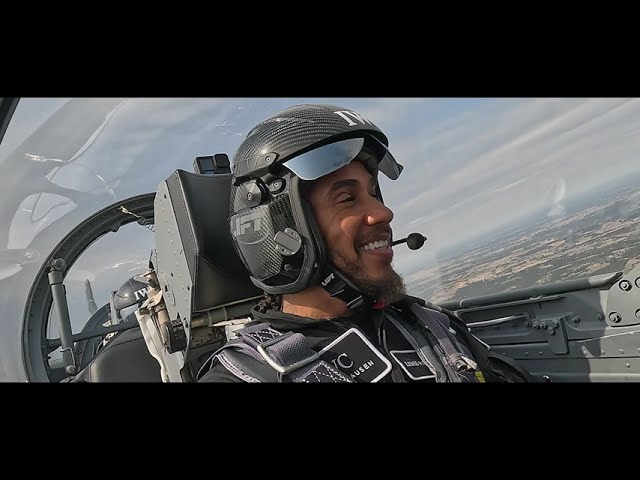In a compelling new short movie produced by IWC Schaffhausen, Mercedes-AMG PETRONAS Formula One™ Team driver Lewis Hamilton embarks on a flight training for astronauts. The same training was used to prepare the crews of the Inspiration 4 and Polaris Dawn commercial human spaceflight missions. During the training day, the seven-time Formula One™ world champion and IWC brand ambassador was accompanied by students from Dibia DREAM, a non-profit organisation fostering STEM education. Their presence is also a reminder of Lewis Hamilton’s own incredible career journey spanning more than three decades and sends an inspiring message: you can be anything you want in life – a pilot on the racetrack, in the air or even in space.
One of the most successful racing drivers of all time, Lewis Hamilton is a multifaceted personality, whose interests and ambitions extend far beyond his sport. The seven-time Formula One™ world champion is deeply fascinated by space and human space exploration. He has visited renowned space training facilities and repeatedly expressed his desire to take part in a space mission in the future if it serves a purpose and contributes to the betterment of all humanity. IWC Schaffhausen now teamed up with the Polaris Program and its Philanthropy Director and instructor pilot, John “Slick” Baum, to offer Lewis Hamilton an opportunity to experience the flight training that is part of the organisation’s programme of preparing astronauts for space. The Polaris Program, which is supported by IWC, recently completed the first of three human spaceflight missions. During their five days in orbit, the Polaris Dawn crew wrote history by successfully performing the first commercial spacewalk.

“Since Lewis Hamilton became an IWC Brand Ambassador in 2013, we have created so many unforgettable moments and memories together. As his record-breaking era with the Mercedes-AMG PETRONAS Formula One™ Team now draws to a close, we are excited to give him an opportunity to complete a flight training for astronauts and bring him one step closer to space exploration.”
Chris Grainger-Herr, CEO of IWC Schaffhausen

FLIGHT TRAINING IS ESSENTIAL FOR ASTRONAUTS
Fighter jet training has been at the heart of human spaceflight since the beginning. All early astronauts were fighter jet pilots, and experience in piloting a jet was an essential requirement for going to space. Flight training was also a key pillar in the preparation of the Inspiration 4 and Polaris Dawn crews for their missions. While the g-loads experienced in a jet or a rocket cannot be directly compared as they affect the body in different ways, jet training still offers compelling benefits for astronauts. Most importantly, it allows the crew members to familiarise themselves with operating in a high-risk and high-consequence environment, similar to what they would experience during launch. While they are pressed down into their seats by several times their own body weight, they have to communicate with each other, go through extensive technical checklists and monitor critical flight parameters – all while being mentally aware of their surroundings and prepared to act in case something unexpected should happen.

A COMPLETE SEQUENCE OF TRAINING MANOEUVRES
Lewis Hamilton’s space training kicked off with an extensive briefing and inspection of the L-39 Albatros jet. John “Slick” Baum gave Lewis Hamilton a detailed overview of the manoeuvres they would fly and how they simulate different situations an astronaut experiences during a spaceflight. During their subsequent discovery flight lasting almost one hour, Lewis Hamilton and his instructor performed a series of manoeuvres. They practiced accelerations and decelerations to experience lateral g-forces, simulating the ascent of a rocket. They also practiced higher g-loads by banking or pitching the aircraft hard. A highlight was flying a parabola figure for a zero-g demonstration, during which Lewis Hamilton briefly experienced the feeling of weightlessness. A racing glove, which eventually began to float freely in the cockpit, was used as a zero-g indicator. In flight, the F1™ pilot pulled a maximum of 7.5 g, which is more than astronauts typically experience on ascent.

“We put Lewis Hamilton through the same training we used to prepare the Inspiration 4 and Polaris Dawn crews for their missions. He showed truly impressive skills at the controls of the jet and proved that he can pilot any machine, whether it is a powerful race car or a jet. With the astronaut flight training for Lewis Hamilton, we underscore the Polaris Program’s commitment to making space exploration accessible to more people.”
John “Slick” Baum, Philanthropy Director and Instructor Pilot of the Polaris Program

Lewis Hamilton wore a dedicated race suit featuring a “space mission” patch with his car number 44. He will wear the same suit during this weekend’s race at the Lusail International Circuit in Qatar. In flight, he wore the Pilot’s Watch Performance Chronograph 41 Mercedes-AMG PETRONAS Formula One™ Team (Ref. IW388306). With its highly scratch-resistant and resilient Ceratanium® case, it is the perfect watch to withstand the harsh conditions in the jet cockpit.

DIBIA DREAM STUDENTS SEND A POWERFUL MESSAGE
The training was also attended by a group of students from Dibia DREAM. This nonprofit organisation sparks social change through STEM education and recreational activities for underserved youth and has impacted the lives of 40,000 students across 32 states and 12 countries. The students spent the entire day engaging in a variety of activities related to space exploration. They also got a chance to meet with Lewis Hamilton and ask him questions prior to take-off. Their presence served as a powerful reminder of Lewis Hamilton’s incredible journey, from his humble beginnings in karting at the age of eight to becoming one of the most acclaimed drivers in the history of motorsport. As the students cheered alongside the runway, they sent an uplifting message to youths around the world: you can be anything you want in life – whether it is a racing driver, a pilot or even an astronaut.














